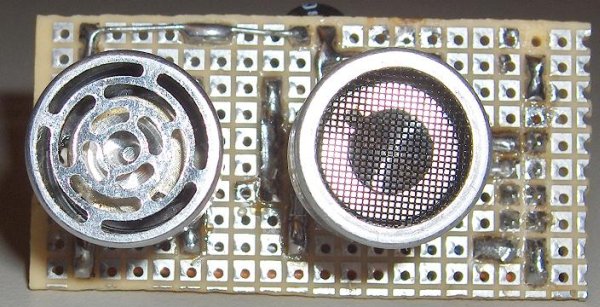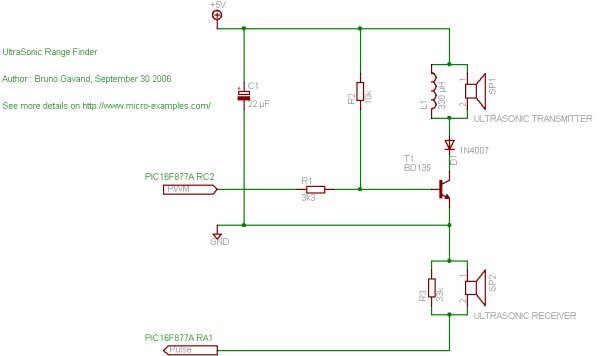HOW DOES IT WORK & CIRCUIT SCHEMATIC
Everybody knows the speed of the sound in the dry air is around 340 m/s. Send a short ultrasonic pulse at 40 Khz in the air, and try to listen to the echo. Of course you won’t hear anything, but with an ultrasonic sensor the back pulse can be detected. If you know the time of the forth & back travel of the ultrasonic wave, you know the distance, divide the distance by two and you know the range from the ultrasonic sensor to the first obstacle in front of it.
Here we use an ultrasonic piezzo transmitter with its receiver, they are very efficient, easy to find and quite cheap.
First, we have to send the pulse : it is easy to get a 40 Khz pulse from a PIC PWM output. You can drive an ultrasonic transmitter directly from the PIC output, but the sense range will not exceed 50 cm. Using a transistor and a resonator circuit, the ultrasonic transmitter will get around 20 volts and the sense range will be extended up to 200 cm.
Second we have to sense the echo : the piezzo receiver can provide a few dozens of millivolt, this will be enough for a PIC ADC with 4 mV resolution without extra hardware.
Click on schematic to enlarge
C1 is a decoupling capacitor
The PWM pulse from the RC2 pin of the PIC drives the T1 transistor base through R1 resistor
A 330 µH inductor is added in parallel to the piezzo ultrasonic transceiver, to form a LC resonnator, the D1 diode protects T1 from reverse voltage.
The ultrasonic receiver is directly connected to the RA1 pin of the PIC (ADC channel number 1), with R3 in parallel as impedance adaptator.
The prototype board
<- Component side
Solder side ->
Take care to align as best as possibe the transmitter with the receiver
SOURCE CODE
Here is the mikroC source code :
| /* * file : sonar.c * project : Simple UltraSonic Range Finder * author : Bruno Gavand * compiler : mikroC V6.2 * date : september 30, 2006 * * description : * This is a basic ultrasonic range finder, from 30 to 200 centimeters * * target device : * PIC16F877A with 8 Mhz crystal * or any PIC with at least one ADC and PWM channel * * configuration bits : * HS clock * no watchdog * no power up timer * no brown out * LVP disabled * data EE protect disabled * ICD disabled * * see more details and schematic on http://www.micro-examples.com/ *//******************** * MACRO DEFINITIONS ********************/ /* * ultra sonic pulse length in microseconds */ #define PULSELEN 300 /* /* /******************* unsigned int buf[BUFSIZE] ; // samples buffer /***************************************** /************ TRISA = 0xff ; // PORTA as inputs TRISC = 0 ; // PORTC as outputs // TIMER1 settings #ifdef LCDPORT Lcd_Out(1, 1, “UltraSonicRanger”) ; |
For more detail: A Cheap Ultrasonic Range Finder
The post A Cheap Ultrasonic Range Finder appeared first on PIC Microcontroller.

















